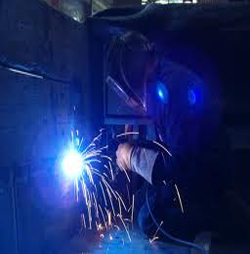Those interested in turning a passion for working with metal into a career should first know the basics, such as what is welding and fabrication, how to draw and read blueprints, as well as how to use computer-aided design programs.
Most employers hire welders and fabricators even with just vocational training and hands-on experience through apprenticeships, as long as they know what is welding and fabrication. However, since some tools require certification, the career opportunities may be limited. As such, advanced welding and fabrication certifications, whether through associate’s or bachelor’s degree programs, are more desirable.
Aside from starting their own welding business, these tradesmen can also specialize in advanced fields such as underwater welding, or seek jobs in factories and industrial companies. Those with their own businesses can also contract their services to bigger companies.
Welders and fabricators are both in great demand due to the highly specialized skill sets required and the amount of jobs available in the construction or manufacturing industries. These tradesmen command high salaries, around $25,000 to $75,000 per year, depending on location, specialization, classification and if he/she is a union member. Generally, union workers receive higher income.
Back to Top
What is welding and fabrication?
The theory behind understanding what is welding and fabrication is easy, but the hands-on practice requires precise skills and knowledge of tools. Welding and fabrication is two types of processes involved in metalworking. These are regularly used in the manufacturing industry of vehicles, automobile parts and engines, household appliances, and structures, among others.- Welding – Welding is the process of joining materials together by heating the surfaces using lasers, gas flame, friction, electron beam, ultrasound or even an electric arc.
- Fabrication – Fabrication is the forming of metals into various sizes and forms by joining or welding metal together. Fabrication also involves reading blueprints, making layouts, cutting metal and actual assembly. Metal fabrication is classified into two types – light (for 3mm-thick metals and below) and heavy fabrication (for any metal thicker than 3mm).
Start Early: Learn Welding and Fabrication in High School
While anyone who has a relative involved in the metalworking industry can learn what is welding and fabrication hands-on in a garage, others aren’t so lucky. If you’re interested in mastering the craft, you can start as early as high school. Many vocational and technical schools nowadays offer welding and fabrication courses even for high school students. Basic lessons in metal welding and fabrication involve smaller projects, but still teach necessary skills like blueprint reading and layout.Most employers hire welders and fabricators even with just vocational training and hands-on experience through apprenticeships, as long as they know what is welding and fabrication. However, since some tools require certification, the career opportunities may be limited. As such, advanced welding and fabrication certifications, whether through associate’s or bachelor’s degree programs, are more desirable.
Career Opportunities and Earning Potential
Welding and fabrication is perfect for people who love reading engineering blueprints when building, welding and constructing various metal products and structures. Although training tacklesthe technical skills related to welding and construction, hands-on practice allows for the development of these specialized skills. After finishing the basic trade training or while completing an apprenticeship program, welders and fabricators can obtain employment in different fields.Aside from starting their own welding business, these tradesmen can also specialize in advanced fields such as underwater welding, or seek jobs in factories and industrial companies. Those with their own businesses can also contract their services to bigger companies.
Welders and fabricators are both in great demand due to the highly specialized skill sets required and the amount of jobs available in the construction or manufacturing industries. These tradesmen command high salaries, around $25,000 to $75,000 per year, depending on location, specialization, classification and if he/she is a union member. Generally, union workers receive higher income.
Back to Top
Fabrication and Welding

Fabrication and Welding Resources
- Home
- Custom Fabrication and Welding
- Fabrication and Welding Apprenticeships
- Fabrication and Welding Books
- Fabrication and Welding Companies
- Fabrication and Welding Courses
- Fabrication and Welding Engineering
- Fabrication and Welding Jobs
- Fabrication and Welding Schools
- Metal Fabrication and Welding
- Plastic Fabrication and Welding
- Precision Fabrication and Welding
- Stainless Steel Fabrication and Welding
- What is Welding and Fabrication
Sponsored Links
